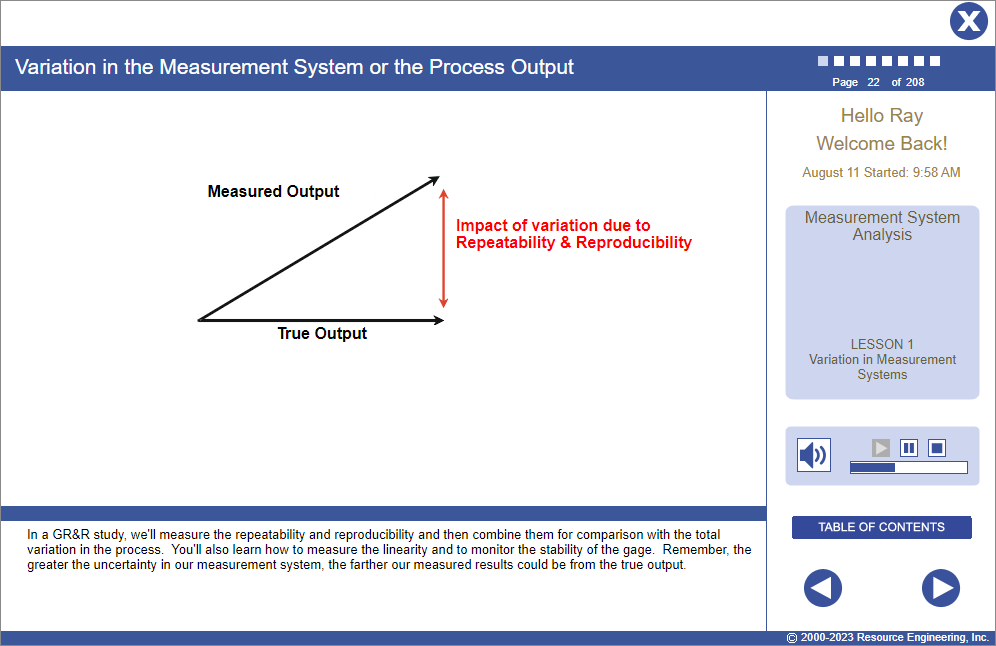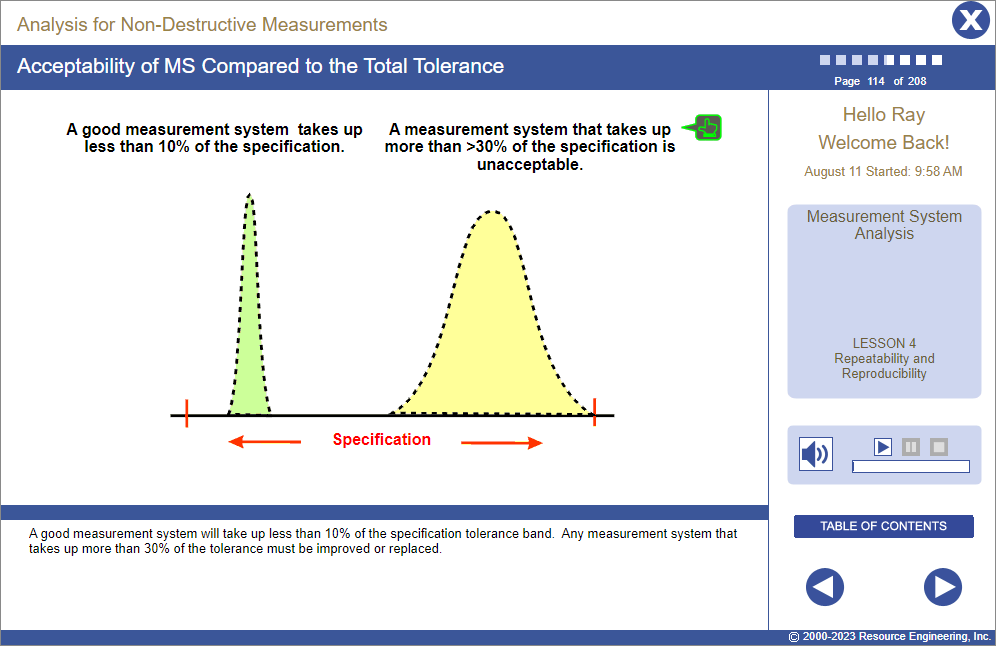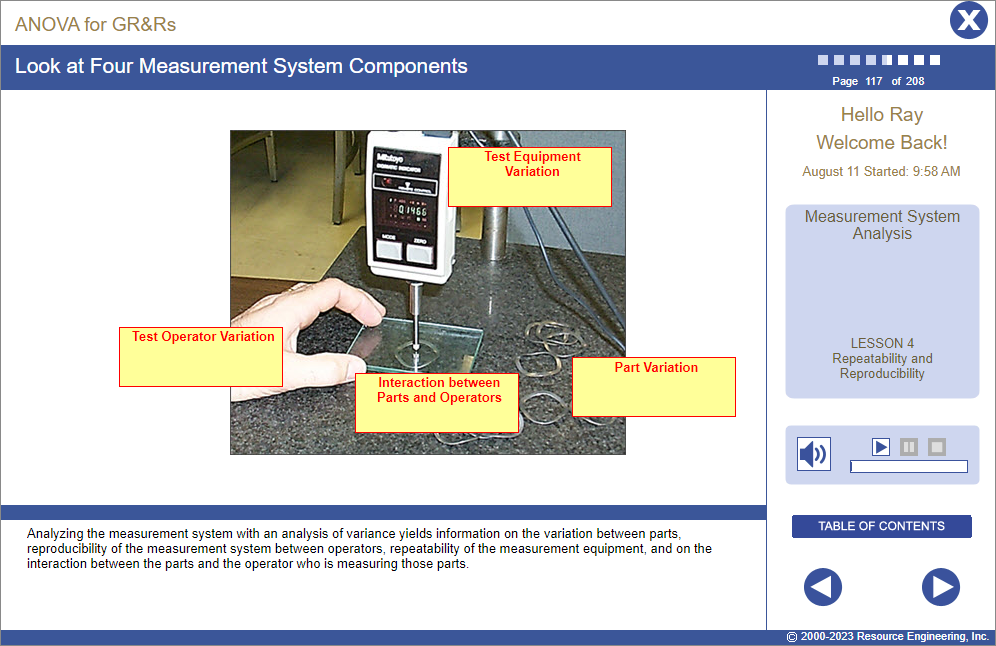Course Information
Measurement System Analysis Training
Learners will be able to:
- Explain sources of measurement system uncertainty.
- Conduct studies of measurement systems including assessments of linearity, stability, repeatability, and reproducibility.
- Improve the measurement system using data collected during the measurement system analysis.

About This Course
Not every organization is aware of the importance of understanding and quantifying the variation in measurement systems. Without a good measurement system, there is no real way of knowing what the output of a process really is! We may think that we are producing good parts based on measurements made only to find out that the parts are seriously defective or out-of-tolerance because the measuring device used is inaccurate, out-of-calibration, or not stable.
GR&R Studies are the most widely accepted techniques for evaluating the level of variation in a measurement system and determining if the evaluated measurement system is acceptable for use.
MSA (Measurement Systems Analysis) online training includes detailed tutorials on many measurement system analysis techniques including how to conduct and analyze GR&R (Gage Repeatability and Reproducibility) Studies. A GR&R is the accepted technique for evaluating the level of variation in a measurement system and determining if the measurement system is acceptable for use. Measurement System Analysis covers techniques for analyzing the variation within a measurement system, determining its suitability for use, and ways to improve measurement systems. The GR&R analysis techniques used in the MSA online training program are in compliance with IATF 16949/AIAG methods.
- A solid understanding of statistical measures of variation covered in Basic SPC and Advanced SPC or the equivalent.
- Experience with basic measuring concepts and an understanding of sources of variation in measurement systems such as what is covered in Gage Training or the equivalent.
- English (EN-US)
- Chinese (simplified) (ZH)
- Czech (CS)
- French (FR)
- German (DE)
- Italian (IT)
- Japanese (no audio) (JA)
- Korean (no audio) (KO)
- Polish (PL)
- Portuguese (Brazilian) (PT-BR)
- Romanian RO)
- Russian (RU)
- Spanish (ES)
- Vietnamese (no audio) (VI)
Course Objectives
In this course, you will learn the techniques for analyzing the variation contained within a measurement system itself. After completing this course, you should be able to:
- Know the common sources of measurement system variation.
- Understand both Type A and Type B evaluations of measurement uncertainty.
- Use both graphical and mathematical techniques to evaluate gage or instrument linearity and stability, and initiate action to address linearity or stability issues.
- Know how to plan and conduct a GR&R study.
- Perform R&R analysis for non-destructive measurements, for destructive measurements, and for attribute measurements.
- Use ANOVA and graphical techniques for the R&R analysis.
- Use the GR&R data to initiate action to improve the measurement device’s repeatability and reproducibility.
Course Outline
Lesson 1 | Variation in Measurement Systems
- A review of sources of measurement system variation.
- An explanation of Type A and Type B evaluations of measurement uncertainty.
- Exploration of the effects of too much variation on measurements.
Lesson 2 | Measurement System Linearity
- How to measure gage/instrument linearity (both graphically and mathematically) to determine if a gage (or instrument) has linearity problems.
- Taking action to deal with linearity problems.
Lesson 3 | Measurement System Stability
- How to evaluate gage/instrument stability using a control chart. Taking action to deal with stability problems.
Lesson 4 | Repeatability & Reproducibility
- How to conduct a GR&R study.
- R&R analysis for non-destructive measurements.
- Use of ANOVA for GR&Rs.
- R&R analysis for destructive measurements.
- R&R analysis for attribute measurements.
- Graphical techniques to analyze R&R.
Lesson 5 | Improving Measurement Systems
- Using a problem-solving approach to find the root causes of repeatability and reproducibility problems.
- Using the GR&R data to help direct the problem-solving effort.
- A description of some basic causes to investigate if gage/instrument repeatability is high.
- A description of some basic causes to investigate if appraiser reproducibility is high.
Lesson 6 | MSA Software Considerations
- Suggested selection criteria for features of software programs for analyzing GR&R studies.
- An overview of some of the advanced measurement system analysis tools that a GR&R software package may have.
Challenge
- An assessment of the learner’s progress in this Unit.

4.4 out of 5 stars
Comments from Learners About This Course
- Very good training guide.
- Great course!
- Interesting training
You may also be interested in…
- DOE: Screening Experiments – Comprehensive training in one of the most powerful families of Designs of Experiments – Screening Experiments. Includes training in both Plackett-Burman designs and Taguchi techniques.
- Managing Calibration Programs – Training in how to institute a formal system to manage the measurement system to ensure that it continues to be reliable and dependable.
- Gage Training – Comprehensive training in how to use a variety precision hand gages including an overview of basic measuring concepts, introductory blueprint reading, an overview of GD&T, and which gages to use when.





